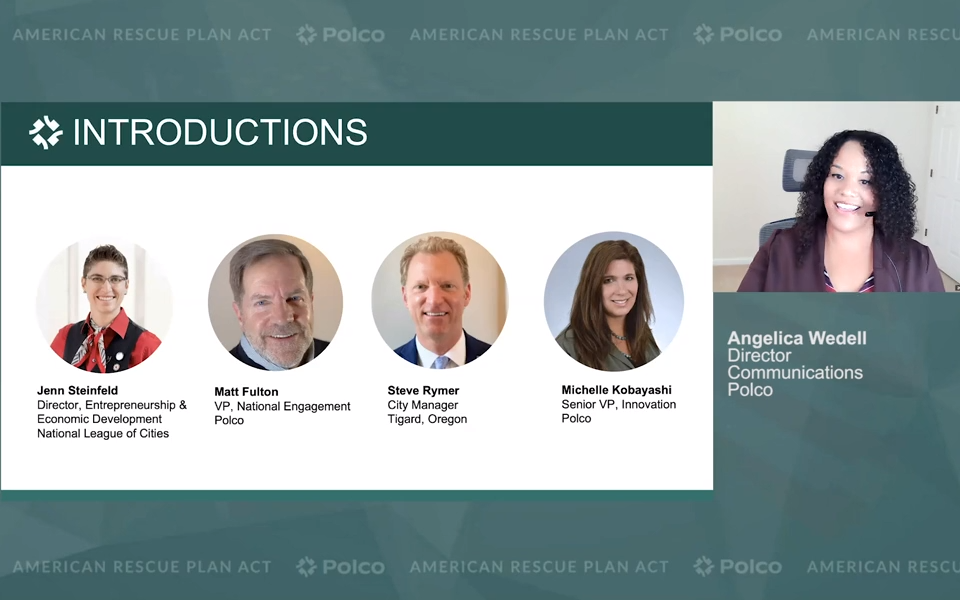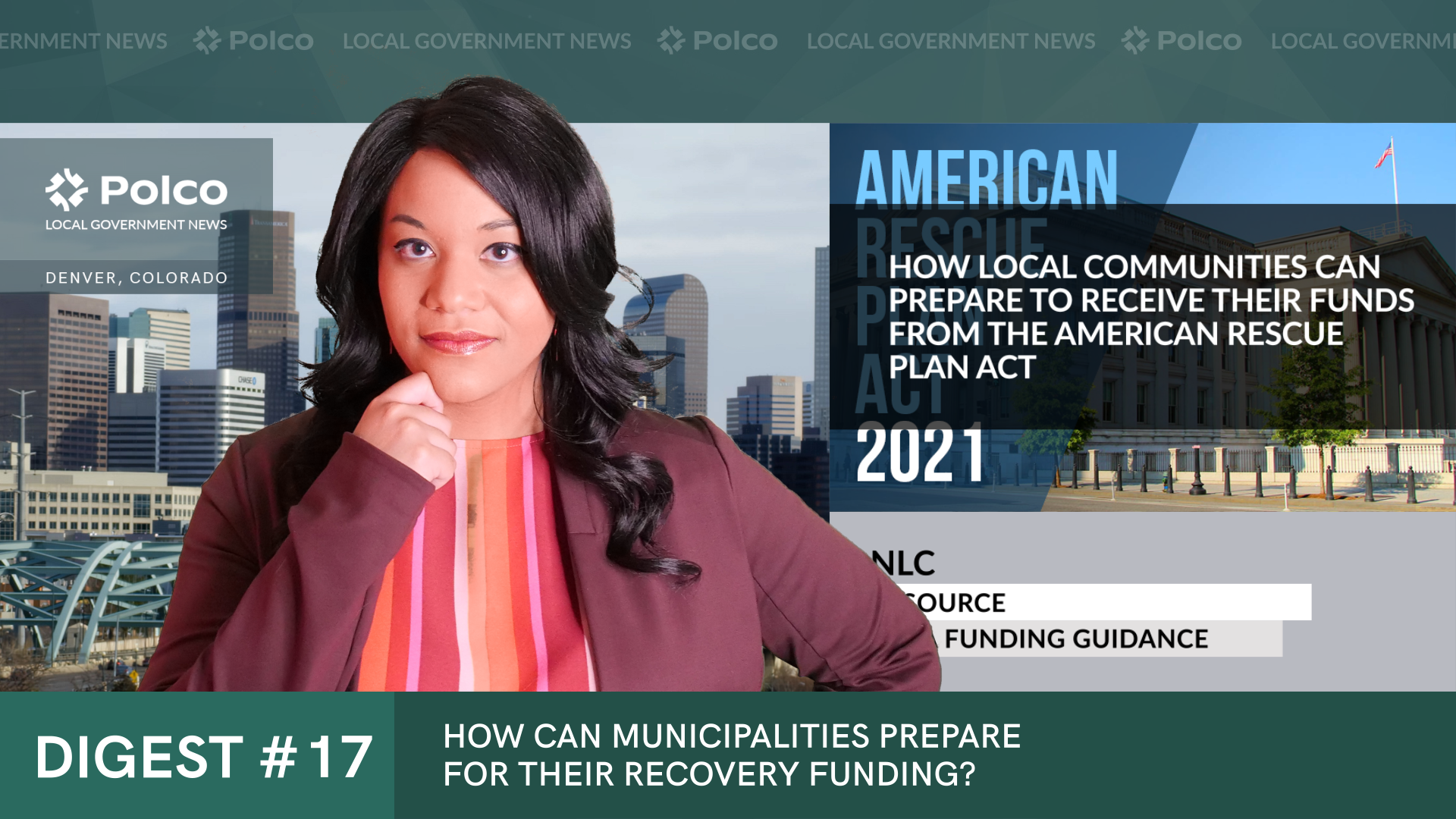Allocating ARPA Funds? How Engaging Your Community Will Help
By Polco on August 19, 2021

- Webinar hosted by Polco and National League of Cities -
Local governments nationwide have received American Rescue Plan Act Funds. But what is the best way to allocate them?
Treasury Guidelines urge local governments to involve their residents in deciding how to best spend the funds. And experts agree.
“Engaging your residents will help you allocate your dollars more effectively and efficiently because you’ll have a better sense for where to align your resources,” said Matt Fulton, Vice President of National Engagement for Polco.
To find answers on how communities can best use their ARPA funds, we spoke with Jenn Steinfield, Director of Entrepreneurship and Economic Development for National League of Cities. We also spoke with Steve Rymer, City Manager for Tigard, Oregon. Last, we spoke with Matt Fulton and Michelle Kobayashi from Polco. These experts are leaders in how best to engage residents in developing a plan for ARPA.
Polco’s Director of Marketing and Communications Angelica Wedell facilitated conversations with Steinfield, Rymer, Fulton, and Kobayashi about how to get the most out of ARPA funds. They also share more information about Polco’s new ARPA Engagement Package.
- Webinar Slides
- Learn more about the ARPA Engagement Package
ARPA: Rebuilding and Reopening
The ARPA program has been designed to address three main areas: 1) local government operations, 2) stability for households and individuals impacted by COVID-19, and 2) stability to small businesses and industries impacted by COVID-19.
“With ARPA, The Treasury is very much encouraging a focus on an equitable recovery and, especially, looking at long term benefits for health and economic outcomes. The CARES Act was more intended for that emergency response, while ARPA is intended to be more about rebuilding and reopening,” said Steinfield.
According to the Treasury, you should consider three things as you are planning how to spend your ARPA funds.
- COVID-19 Related Harm: Funds should address an economic harm resulting from or exacerbated by the pandemic.
- Proportional Assistance: Funding must be reasonably proportional to the extent and type of harm experienced. This means that communities should assess where the most damage has been caused as a result of the pandemic and address that.
- Flexible Criteria: Recipients should consider local conditions and local data.
To make your dollars stretch, Steinfield recommends using targeted funding sources such as block grants and competitive grant funds first before deciding how to spend the more flexible local fiscal relief fund.
Some specific examples of eligible uses for ARPA include loans or grants to mitigate financial hardship. This could include supporting payroll and benefit costs or mortgage payments etc. Another example includes loans, grants, or in-kind assistance to implement COVID-19 prevention or mitigation tactics. This might include physical plant changes, enhanced cleaning efforts, or vaccination programs. A last example might be technical assistance or other services to assist with business planning needs.
Steinfield provides some advice related to reporting and record-keeping. Local governments will need to report on any funding provided to private sector businesses and keep close records of their spending.
“Maintain those records and really help the Treasury to understand how you used local funds to offset the disproportionate and negative impacts of COVID-19,” said Steinfield.
Whatever your questions about ARPA, governments can turn to National League of Cities (NLC) to help out. NLC has a COVID-19 hub that includes blogs, fact sheets, Frequently Asked Questions, webinar recordings, and a Local Action Tracker. NLC also encourages people to ask questions via a form. These questions help NLC know what content to create and what to talk with The Treasury about.
Engagement As An Organizational Value
“With ARPA , there is this unique opportunity to transform your communities, using the best information and the voices of many,” said Fulton.
So how do you get the best information and bring in the voices of many? Fulton says one key factor is making engagement part of the culture.
“We need to make engagement an internal organizational value that you live and breathe,” said Fulton.
One way to do that is to lower the barriers to participation. This includes using culturally relevant practices such as translation and reaching out to people using their preferred mode of outreach and communication. Another way to lower barriers to participation is to partner with trusted community leaders such as schools, businesses, religious organizations, or community-based agencies.
Once you have grown a community of respondents, keep them engaged. Polco’s online engagement platform helps you to send out short polls regularly. People will continue to want to provide feedback if you clearly communicate how that feedback informs decisions.
Last, Fulton urges local governments to consider how they are engaging throughout the policy cycle.
“There’s so much noise that communities are struggling with right now. To cut through the noise, you’ll want to get feedback throughout the decision-making lifecycle. You’ll want to have a performance system in place that will allow you to formally and objectively track your success,” said Fulton.
Tigard, Oregon's Story
Tigard, Oregon is one example of a city that has embraced a culture of engagement. Tigard is near Portland, Oregon and has a population of almost 55,000.
“We have embraced engagement to the point where we literally track our communications on a weekly basis via a constituent communications dashboard. We report this data out,” said Rymer.
Another example of Tigard’s commitment to engagement is the way in which they formed a Public Safety Advisory Board. The Council made all the interviews and applications for the board public and the community offered significant input.
The City also engaged residents to update their Strategic Plan, as well as the Parks and Recreation Plan and Library Plan. Because they revised these plans during the pandemic, they relied much more on technology such as virtual meetings and surveys than in the past. They also held pop up engagements in parks.
Through these strategic planning processes, the Community developed five different categories to focus on and four city imperatives. These will guide the City’s budgeting process and will now also guide their plans for how to spend ARPA funds.
“We’re hoping to build off what we've heard from conversations that we've had for a couple years as we decide how to spend the ARPA investment,” said Rymer.
Tigard is now delving into specifics around how much ARPA funds to dedicate to each category. They are involving key partners in the conversation, such as the County, State, and Community Based Organizations. As much as possible, they are planning to use existing metrics to track their progress.
“One of our biggest lessons is to align the ARPA funding plan with our Community vision. It gives us that compass that everyone understands as a starting point,” said Rymer.
The ARPA Engagement Package
“The pandemic turned our world upside down...Once we start identifying the impacts from COVID-19 and couple that with pre-existing issues we have in our communities, the money doesn’t go as far as we’d like. Plus in many communities there are competing needs and different priorities. For these reasons, it’s more important than ever for you to engage your residents and business leaders in these decisions,” said Kobayashi.
The ARPA Engagement Package from Polco and National League of Cities is a tool that can help Cities engage their residents and businesses to make the best possible decisions on how to spend ARPA Funds.
The cornerstone of the Engagement Package is a survey of residents and business owners. The survey is designed to be administered multiple times to gauge progress. It includes questions on overall community quality of life, personal and business impact of the pandemic, and advice for how to spend the ARPA funds. The survey also looks at disparities across groups.
“Not only are we going to try to bring the entire community up in terms of quality and recovery, but also we’d like to shrink those disparities over time. So these dashboards will really help you meet those goals of equity,” said Kobayashi.
Another goal of the ARPA Engagement Package is to support collaboration. Leaders can share challenges and questions via the virtual community Polco Connect. Polco and NLC also plan to aggregate the data in order to identify impactful approaches to recovery as well as trends across states and regions. These trends will help communities to be able to share information, best practices, and problem solve together.
“We’re in this new trial and error period in post pandemic planning. We want people to be able to connect with each other,” said Kobayashi.
Learn more about the ARPA Engagement Package.
Related Articles:
- Community Equity and Allocating ARPA Funds
- How Community Feedback Drives Economic Success With ARPA Funds
- How Your City Can Spend ARPA Funds With an Equity Lens
Popular posts
Sign-up for Updates
You May Also Like
These Related Stories

How Community Feedback Drives Economic Success With ARPA Funds

Community Equity and Allocating ARPA Funds

